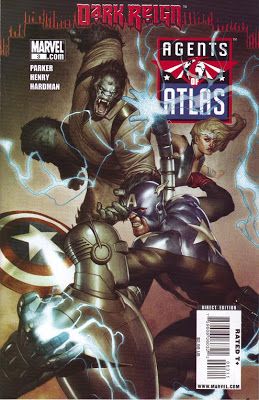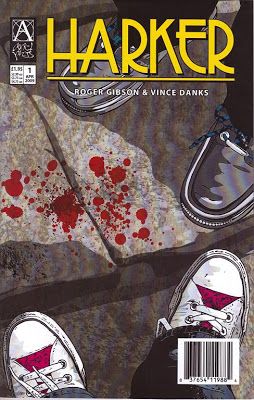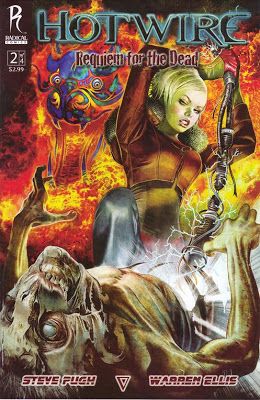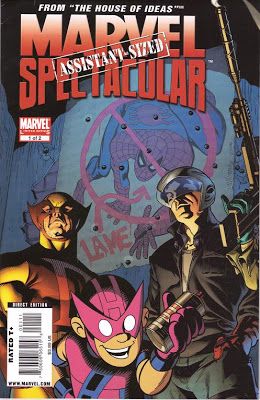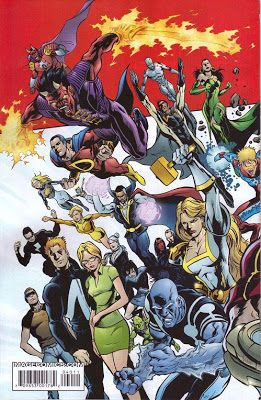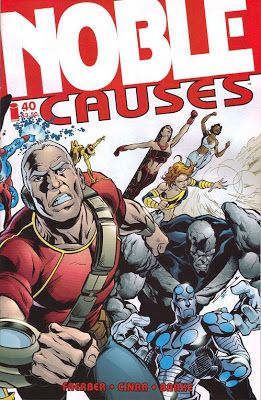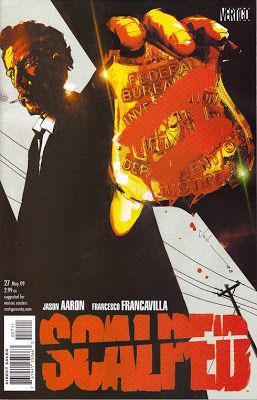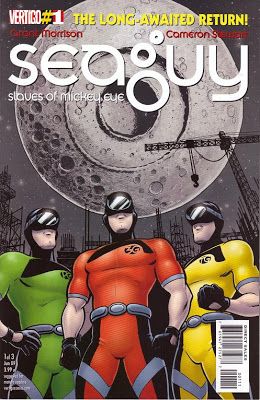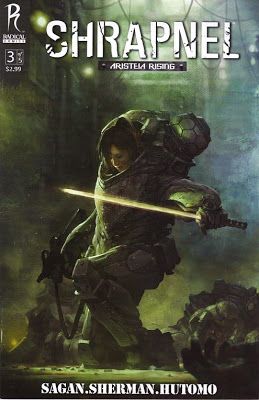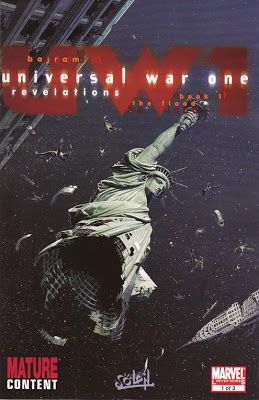You know, there are people in this world who protest when some of us proclaim Geoff Johns to be bloodthirsty. Those people, I would suggest, might want to skip the first three pages of the new Flash comic. I'm just sayin'. But you won't find overwrought paeans to a character who is far more interesting as a corpse below the jump, no sir! Just look if you don't believe me!
Agents of Atlas #3 ("The Dragon's Corridor"/"Interlude at Sea") by Jeff Parker (writer), Gabriel Hardman (artist, "The Dragon's Corridor"), Clayton Henry (artist, "Interlude at Sea"), Elizabeth Dismang (colorist, "The Dragon's Corridor"), Jana Schirmer (colorist, "Interlude at Sea"), and Nate Piekos (letterer). $2.99, 22 pgs, FC, Marvel.
Continuing the inappropriate cover art for Agents of Atlas, we get Adi Granov and his eerily sterile look. He draws a killer robot, as we can see in the foreground, but Ken Hale and Bucky look a bit stiff. Oh well. I guess that's what we're going to get with this series.
I have mentioned not digging Pagulayan's art on the first two issues, and someone mentioned it was probably Jana Schirmer's coloring, and what do you know? that person was right, as Clayton Henry's strong lines from The Incredible Hercules are muted in this issue, and while it's better than Pagulayan's art, it's still not as good as it could be. Hardman's art is still better than either.
Parker does a nice job in the present story with Atlas and its bargaining with Norman Osborn - it feels like "real-world" power brokering (yes, even with the superheroes hanging around) and is far more interesting than the main "Dark Reign" crap Marvel is pushing on us. Osborn is obviously nuts, but gleefully so. I'm not as impressed with Venus consoling Namora about Namorita, as it's difficult to get too worked up over those kinds of scenes in corporate comics, considering the long history people have of coming back. Parker does what he can, though. I'm a bit confused about two things, though. On the 11th page of story, Namora blows up a mine. It's a weird sequence. She gets angry at Venus because of the live mines lying around, so she blows one up right in front of her. It's unclear how she makes it explode or why the explosion is so small. It's kind of weird. Then, on page 17, Osborn shows up to inspect his wares. There's a long shot of the big tanker on which Atlas houses its labs. There are clearly four people standing on the deck, presumably Ken Hale, Temugin, Bob, and M-11. Ken calls Temugin "Timmy," and Temugin angrily tells him that's not appreciated. Then, in the next panel, Osborn is standing there with the Sentry. Did they teleport? How? Did the Sentry fly them there real quick-like? Temugin, who knew that Osborn was coming (as he says something to that effect in the first panel), leaps at the Sentry to kick him. The Sentry grabs his foot and tosses him in the river. It's quite a funny scene, especially as the Agents make no move to help Temugin, but why would he try to kick the Sentry in the head? He knew Osborn was coming. How did Osborn get there? Does anyone have a theory?
The 1958 story is more fun, anyway. Bob gets drunk, M-11 slaughters a bunch of bad guys (but in a fun way!), the team uses red plastic triangles to teleport to a strange landscape scattered with skeletons. Now that's comic-bookery! I certainly don't mind the story set in the present, but the one from the 1950s kicks its ass.
You know, deep down in your heart of hearts, that you want to buy this. Give in!
Harker #1 by Roger Gibson (writer/letterer) and Vincent Danks (artist). $2.99, 22 pgs, BW, Ariel Press.
I've become very nervous about buying self-published comics or comics from tiny publishers that claim to be "ongoing" or even more than one issue, because so many publishers disappear so quickly and so many creators are going on-line, which really butters my biscuits, let me tell you that much.* So it was with trepidation that I ordered this, but I'm glad I did. On the one hand, it's a detective story with occult overtones, which isn't all that interesting, but Gibson does a fine job with the two main characters, Critchley and Harker. Critchley (a Detective Sergeant) and Harker (a Detective Chief Inspector) are a neat pair, as Critchley takes point, flirts with the ladies, and comes up with weird theories, while Harker seems more anti-social and OCD. Neither is fully formed as characters (although Gibson lets us know in a text piece that they're not totally new), but they have a lot of potential. Danks' art is very nice - photo-referenced, sure, but done in a way (sorry, I'm not up on the techniques) that allows him to rough it up and make it more "real" if not "realistic." There's not a lot of action in this issue, but Danks does a good job with the crime scene, making sure the location is as important as the actual murder.
Issue #2 has been solicited, but I haven't seen issue #3 offered (although Gibson says it's coming). I have high hopes for this, because I want these kinds of books to succeed. However, it definitely deserves a look not because it's from a small press, but because it's quite good. Check out the web site if you can't find a copy in the real world!
* If that's not a phrase meaning "makes me grumpy," it should be.
Hotwire: Requiem for the Dead #2 (of 4) ("Dead Letters") by Steve Pugh (writer/artist/letterer) and Warren Ellis (grumpy old man coming up with goofy ideas). $2.99, 22 pgs, FC, Radical Comics.
As always, my thanks go out to Radical for sending me some free comics. It's very cool of them.
Pugh's weird tale continues in this issue, and while the bloom is off the rose with regard to the wackiness of the idea, Pugh is good enough that he keeps the strangeness going. I mean, there's a Chinese dragon ghost in this comic, and it's as awesome as it sounds. The fight with the dragon is the highlight of the comic, as Pugh draws it beautifully and makes it very exciting. He gives us more backstory about what's going on, too, and I can't imagine that the rioting won't tie into the ghost stuff. Pugh also does a nice job bringing up how creepy the whole ghost thing is, as Alice gets voice messages from her dead mother. It's a nice touch.
I'm really liking this book. It looks very nice, has a cool hook, and Pugh is doing a good job with the story. And a dude blows up! Who doesn't like dudes blowing up?
Marvel Assistant-Sized Spectacular #1 (of 2). "Assisted Living" by Chris Eliopoulos (writer), Jacob Chabot (artist), and Dave Sharpe (letterer); "D-Man: Slum City Warriors" by Brian Patchett (writer), Xurxo G. Penalta (artist), José Villarrubia (colorist), and Nate Piekos (letterer); "Just a Little Old Fashioned Justice" by Jason Aaron (writer), Richard Isanove (artist), and Cory Petit (letterer); "Hawkeye and the Curse of the Crimson Crown" by Chris Giarrusso (writer/artist). $3.99, 32 pgs, FC, Marvel.
You know, if I were Joey Q, I would seize the reins of the Marvel Universe back from Crazy Bendis (yes, it might get extremely bloody, but that's the way counter-revolutions go sometimes!) and give them to Chris Giarrusso. The other stories in this fun volume are decent enough, but "Hawkeye and the Curse of the Crimson Crown" just might be the best Marvel story ever. EVER!
If only there were a web site where I could post every single panel of the story in total defiance of copyright laws so that you could feel the awesome oozing off the pages of this comic. But I'll muddle through, and I'll summarize without spoiling too much: Hawkeye wakes up to an empty Avengers mansion. He finds a note from Iron Man that reads: "Hawkeye, We went with Archeology [sic] Jackson to find the Crimson Crown. We didn't bother waking you up because you have no powers and are useless to us. You are only an Avenger because Captain America thinks it will stop you from being a bad guy or something. -Iron Man P. S. Don't eat my cake!" Okay, beside the poor spelling, Archaeology Jackson is now the greatest Marvel character in history. In the very next panel, Doctor Strange teleports into the kitchen, and of course, Hawkeye is eating Iron Man's cake. And it only gets awesomer. Dr. Strange and the rest of the gang keep making fun of Hawkeye because he has no powers, Hawkeye keeps bringing up that he beat Iron Man once when there was nothing wrong with his armor, and Hawkeye saves the day but, of course, doesn't get any credit. And we even have the new greatest catchphrase ever: "It's archeology time!"
The other stories are fine, with D-Man forming his own superhero team in Iraq and American Eagle tracking down Cottonmouth on the Navajo reservation (although it would have been funnier if American Eagle had told Cottonmouth that the Navajo, as yet, don't operate any casinos), but come on, once you've read about how Iron Man caused the Curse of the Crimson Crown to be activated and then lied about it, you tend to forget everything else except for how Chris Giarrusso should be new Grand Poobah of Marvel. Make it happen, Joey Q!
Noble Causes #40 by Jay Faerber (writer), Yildiray Cinar (artist), Jacob Baake (colorist), and Charles Pritchett (letterer). $3.50, 21 pgs, FC, Image.
Jay Faerber ends Noble Causes after eight years, and it's kind of a shame. He says he's burned out on the characters, but in this issue, we get an update on Race and Liz which brings up all kinds of questions (the most important being, "Is Race old enough?" - trust me, it's relevant) and a perfectly soapy cliffhanger. Yes, a freakin' cliffhanger in the final issue. The cliffhanger is cribbed directly from an old episode of Cheers (and probably other places, too, but that's what immediately leaped to mind when I read it), but it still seems to imply that although Faerber might be burned out on writing the book, he's certainly not out of ideas for the book. The nice thing is, of course, that he can return to the book (and the characters) whenever he wants, if Image will let him, and he's already promised that the characters will show up in Dynamo 5, so there's that.
I really can't begrudge Faerber the annoying non-ending, as he's done such a wonderful job with this comic for so long. This has been consistently one of the best superhero comics around, and the soap opera elements, for which I'm a sucker (I watch Being Erica, for crying out loud), were always a great part of the experience. If you were ever a fan of Claremont's X-Men when he was at the top of his game, you should check out Noble Causes in one form or another. The second gigantic Archive volume should be out soon, and that's not a bad way to go (even though it's in black and white). I hope that Faerber continues writing these kinds of superhero books, because these are the kinds that put Marvel's and DC's convoluted ones to shame.
Scalped #27 ("High Lonesome Part Three of Five: The Ballad of Baylis Earl Nitz") by Jason Aaron (writer), Francesco Francavilla (artist), Giulia Brusco (colorist), and Steve Wands (letterer). $2.99, 22 pgs, FC, DC/Vertigo.
After last issue's somewhat disappointing tale of Diesel, Aaron gets back on track this time around, as he delves into the life of FBI Agent Nitz, Bad Horse's boss and general all-around dick. This issue does nothing to make him sympathetic, but it does show why he's such a dick, and it makes for an interesting story. We learn what Diesel brought him from Red Crow's office and why it was so important for him to get it, and we learn why Nitz is so focused on Red Crow. One of the more interesting parts of this series has been how Aaron has taken the Pine Ridge killings in 1975 and examined how they affected so many people, and he does this here, as Nitz is tangentially but crucially involved in the shootings. Nothing in here excuses Nitz's behavior, but we can see why he acts the way he does, and we realize that his ex-wife is right - he died a long time ago. This is just his corpse, animated solely by revenge. Unlike last issue, which showed us what a bad-ass Diesel is but didn't add too much to his character (as we already knew Diesel was a bad-ass), this issue is still unpleasant to read (Scalped doesn't go much for "pleasant" reading, after all), but it was a necessary issue and a gripping one, despite the lack of action. We can guess why Nitz is such a scumbag, but it's still fascinating watching it unspool before us.
Francavilla does the art, and it's nice to see him getting a higher profile. Maybe this will lead to more conspicuous work for him!
Seaguy #1 (of 3) ("1/2-an-Animal on a Stick") by Grant "Are You Happy Now, Fanboys?" Morrison (writer), Cameron Stewart (artist), Dave Stewart (colorist), and Todd Klein (letterer). $3.99, 32 pgs, FC, DC/Vertigo.
Oh, God of All Comics, you taunt me with Final Crisis, but then you appease me with Seaguy. Can you just leave DC's big guns behind forever, please? Oh, you can't? You're writing a new Batman comic? Okay, I guess I can live with that. As long as Tony Daniel doesn't draw it!
As you might expect, I dig this comic a lot. Morrison often screws things up royally in terms of storytelling, mainly because he tries to get too clever for his own good, but in this issue, he keeps things simple, and the result is a very nice book. Yes, it's a bit weird, but the story itself is easy to follow, and when Morrison sticks to telling a good story, he's fantastic. Seaguy 2.0 is a riff on something Morrison has done in the past and will (presumably) do in the future - the "real" versus the "fantastic," growing up versus remaining innocent, the forces of "normality" versus the childlike joy of life, commercialism versus hippieism - nothing too stunning, but it works. Morrison's best work comes when he cares enough about the characters to stop the weirdness from overwhelming the story, and that's the case here. He writes Seaguy as a lost soul, someone desperate to know why he's unhappy but unable to figure it out. Of course, because it's a Morrison comic, it's not because Seaguy suffers from a neurological disease, it's because outside forces are actively conspiring against him, but that doesn't obscure the main theme of the book, which is that Seaguy believes that the prefab world in which he lives is somehow wrong and he needs to break out of it. Morrison does a wonderful job capturing this ennui without making Seaguy too much of a mope. The fact that Seaguy's world is more obviously menacing than ours helps. Just when you want to tell Seaguy to stop whining, i-Pol officers show up and creep us the heck out or the scientists at the hospital go all "see no evil, speak no evil, hear no evil" on us. Morrison doesn't let the kookiness overwhelm the basic plot, which is nice.
Cameron Stewart is another on the list of "good" Morrison artists, and really brings up the fact that Morrison, more than a lot of writers, needs a good artist. Can you even imagine Tony Daniel drawing this? Stewart makes a freakin' parrot look menacing in one panel, for crying out loud. He has a wonderful pop-art sensibility that makes Morrison's pop-art world stand out in stark relief to its dark undercurrents. Stewart does a marvelous job with the crypto-saurs, as well. It's a beautiful comic to look at as well as read, and it's nice to see Morrison getting an artist he deserves.
There's a lot going on in Seaguy that I don't feel like getting into here; I'm sure someone like Mr. Tim is already preparing an essay about G-Mozz's weird thing with beards (seriously, what's up with that?). Suffice it to say that this is why those of us who love Morrison love Morrison, and I hope the next five issues (if the planned trilogy ever finishes) are as good.
Shrapnel: Artesia Rising #3 (of 5) by M. Zachary Sherman (writer), Bagus Hutomo (artist), Leos "Okita" Ng (colorist), and Sean Konot (letterer). $2.99, 22 pgs, FC, Radical Comics.
I didn't get the second issue of Shrapnel, and I'm not sure if it's a measure of the book's success or failure that I don't really feel like I missed anything. From the recap page, it doesn't sound like I missed too much, except for a bit of history about our main character, Samantha. I'm not sure what happened in issue #2, but this isn't about that, it's about issue #3!
Unfortunately, this isn't that good a series. I've said before that I appreciate what Radical is doing, with some good production values and a willingness to publish some wild stuff, but unlike Hotwire, this isn't one of their better offerings. I can't even say that if you like science fiction, you'll like this, because it's so very representative of every other science fiction/action/adventure story you've read before. You can anticipate every single plot twist, from the confrontation between Samantha and her former commanding officer, to the real story of what happened when she was drummed out of the marines, to the plan to break into the "elevator" to get the colonists off of Venus. It's done very much by rote, and it's hard to get excited about it.
Similarly, the art remains a problem. Issue #1 was somewhat murky and difficult to scan, and although it's better here, the coloring is still a problem. Grimy and dark sci-fi has become a cliché as well, and it was getting old by the time Outland came out, so it's really old now (Outland was pretty damned cool, however, wasn't it, and yes, I just wanted to make an Outland reference).
I appreciate the fact that Radical sent this to me, but it's not very good. Buy Hotwire instead!
Universal War One: Revelations #1 (of 3) ("The Flood") by Denis Barjam (writer/artist). $5.99, 46 pgs, FC, Marvel/Soleil.
I've been skipping the Soleil books, mainly because they're 6 bucks a pop and I know Marvel is bringing them out in trade paperback, so I've been waiting for those. However, I got the first part of this series in single issues, so I figured I'd keep doing so. It's a sci-fi book, but unlike Shrapnel, Barjam keeps the story fresh and interesting, and his art is very crisp and epic, as befits a sci-fi story. There's time travel in this story, which always makes my head hurt, but Barjam has settled down after the confusion of the end of the first part and keeps it straightforward in this issue. Barjam does a good job building the tension, as a weapon is about to be unleashed on the Earth and our ragtag group of heroes has to stop it. Barjam himself gives the game away on the first page, as does the cover - they can't stop it. The destruction of New York is astonishing, not only because it's beautifully drawn, but because, as Barjam notes in the beginning, he drew it right around 11 September 2001, and the issue came out not long afterward. He said he decided to keep it because the issue is about human madness, much like what 9/11 was. It will be interested to see where Barjam goes with this.
This is a nice comic, worth the money you will spend for it, and it's again nice that Marvel is publishing these kinds of things. Universal War One is a good science fiction story with a lot of nice touches. I still think it would read better in the trade, though.
Well, that's the week. How about we fire up some totally random lyrics!
"Cities come and cities go just like the old empires
When all you do is change your clothes and call that versatile
You got so many colours make a blind man so confused
Then why can't I keep up when you're the only thing I lose?
So I'll just pretend that I know which way to bend
And I'm gonna tell the whole world that you're mine
Just please understand, when I see you clap your hands
If you stick around I'm sure that I'll be fine"
And remember, if you ever wonder what to do when you're bored, might I suggest:
Seriously, Joey Q. IT'S GOLD!!!!!!


